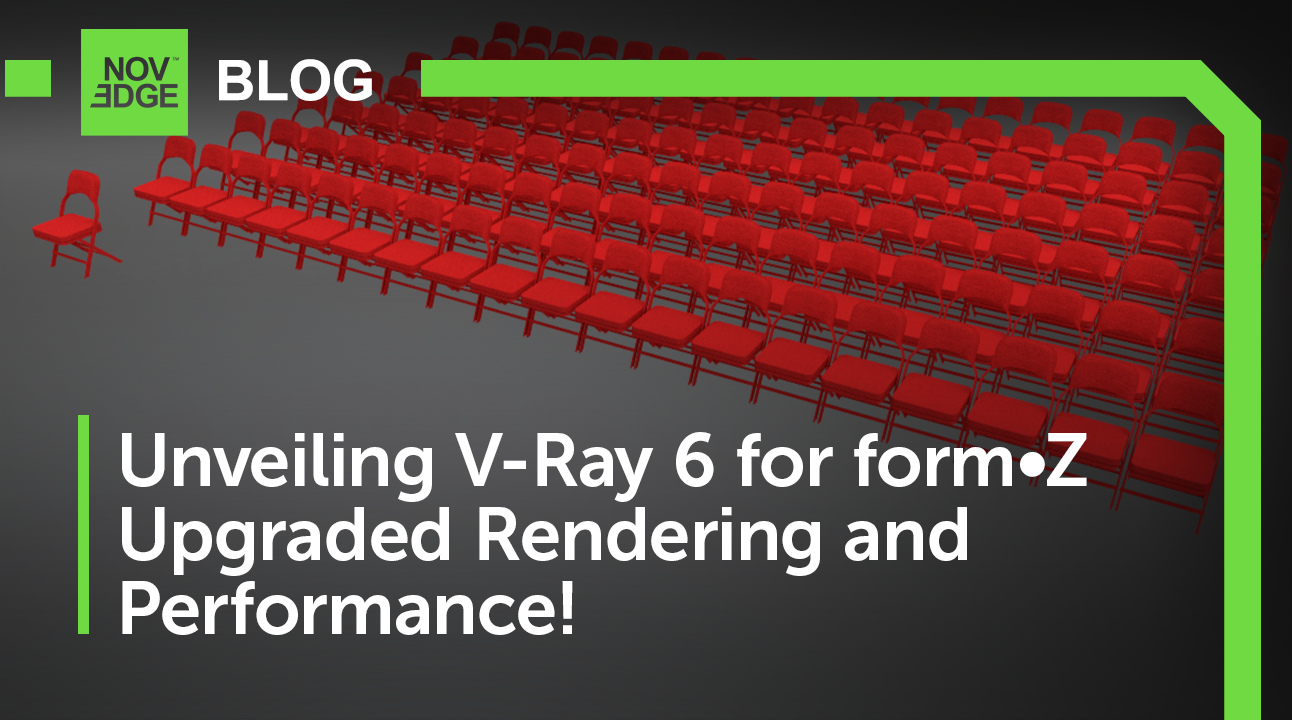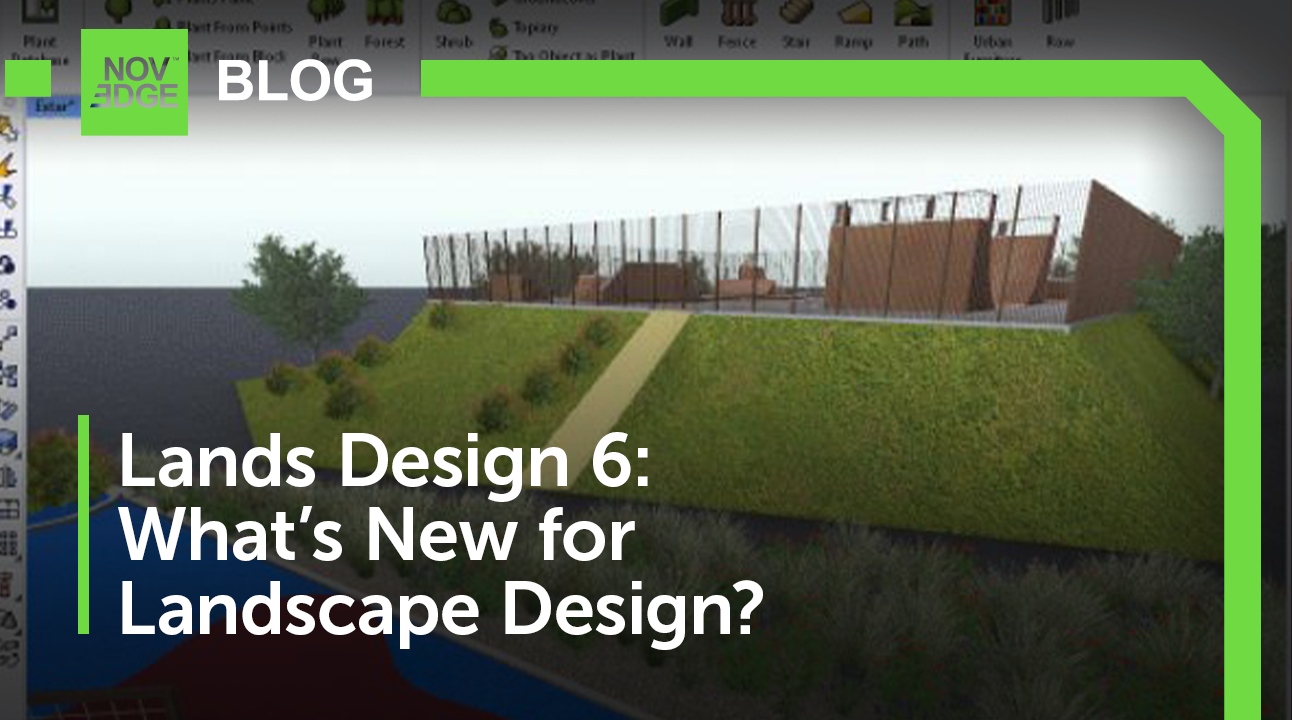Your Cart is Empty
Customer Testimonials
-
"Great customer service. The folks at Novedge were super helpful in navigating a somewhat complicated order including software upgrades and serial numbers in various stages of inactivity. They were friendly and helpful throughout the process.."
Ruben Ruckmark
"Quick & very helpful. We have been using Novedge for years and are very happy with their quick service when we need to make a purchase and excellent support resolving any issues."
Will Woodson
"Scott is the best. He reminds me about subscriptions dates, guides me in the correct direction for updates. He always responds promptly to me. He is literally the reason I continue to work with Novedge and will do so in the future."
Edward Mchugh
"Calvin Lok is “the man”. After my purchase of Sketchup 2021, he called me and provided step-by-step instructions to ease me through difficulties I was having with the setup of my new software."
Mike Borzage
The Edge: Michele Calvano and the Architecture of Folded Surfaces
May 06, 2014 9 min read
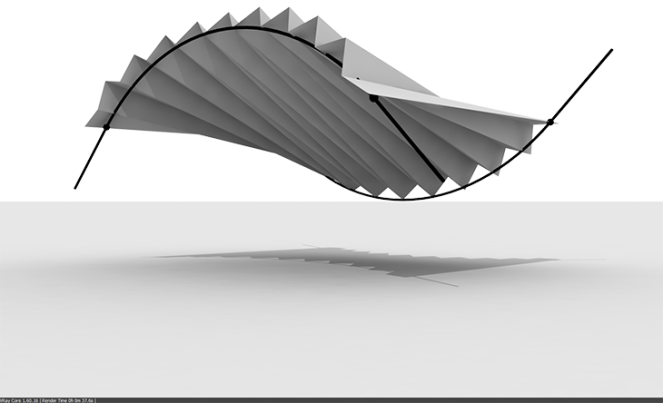
Novedge: Tell us a bit about who you are and what you do.
Michele Calvano: I have been always interested in space and the construction of things. Over time I have become first an architect and then I received my PhD in Architectural Representation, specializing in Mathematical Modeling and Parametric. I write articles on Reverse Modeling and Manufacturing of Forms, and lately I have become interested in the enhancement of cultural heritage through the representation of The City Never Built. I conduct teach at the University Sapienza in Rome, in the Master of Product Design program. At the University of Camerino, in Ascoli Piceno, I carry out drawing classes of SAD. I am also a lecturer at Quasar Design University in Rome. I work as a tutor for McNeel and Autodesk, teaching Rhinoceros and AutoCAD. In addition, I collaborate in the activities of training and research at the Casa dell'Architettura di Latina.

Novedge: On your website, you talk about digital prototyping and modern software as redefining artisan work. Can you talk more about the way you think these new technologies are redefining the roles of manufacturers and designers?
Michele Calvano: The economic situation affecting contemporary societies, and especially Italy, has imposed the need to economically restructure the Italian economy. In the past, the availability of capital allowed us to sustain large, medium and small manufacturing companies that, over time, came to replace the role of the traditional artisan with rapid mass production. The lower economic availability of capital has taken away the foundations of this social structure, making employment in industrial production more and more precarious. Workers who previously found stability at these companies, now find themselves without an “adhesive”, meaning that they find their situation often unstable. However, due to their experience in the factories, they possess technological know-how. There's now a group of people who are technologically aware, who see the hope of economic recovery in the return of handmade manufacturing. The idea is that each person can create his or her own business. For example, more people can now model and build objects by using design software. 3D printing is the most common technology at the moment to produce objects, thanks to its ease of use. It enables designers to economically and rapidly produce their designs.

Obviously I am active in the Maker Movement. However, I think that this movement is still extremely popular only with those who are not experts or professionals: it is still relatively far from the thoughts of designers and architects. In practical terms, 3D printing can produce fully functional objects, but its capacity to reproduce complex design is still “immature” if we look at appearance and design lines.

In my PhD thesis I tried, among other things, to foresee how designers can make use of these technologies in the product’s ideational process, in order to “reconnect” the designers to the use of prototypes. In summary, according to my research, the mental model (the idea) could be represented in various methods: from the paper sketch to the 3D model in the digital space. In this way, the final products have a dynamic relationship with the inventor. At some point, the designer needs a prototype that, with the help of a 3D printer, can be quickly produced. This prototype might not be 100% accurate, but suitable to evaluate its ergonomics and relationship with the environment. Later on it could be subject to changes. And here we find a problem, which is the difficulty of updating the design with the changes made on the prototype. The issue can be resolved through 3D acquisition, for example using the Kinect, or production methods of cloud of points from photo acquisition. The resulting mesh is aligned with the NURBS model previously designed for the 3D printing and through the process of Reverse Modeling, updated to the obtained model. The strength of the process just explained is that this takes place using software widely used, such as Rhinoceros implemented by Grasshopper and consumer devices, which are cameras and scanners for gaming.

Novedge: You recently contributed to a book exploring the geometry behind the art of origami. Can you talk about your research on the topic?
Michele Calvano: The book “Architettura delle Superfici Piegate” [In English: "Architecture of Folded Surfaces"] contains the research that we are carrying out within the DSDRA, the Multidisciplinary Department of the Faculty of Architecture of the University Sapienza in Rome. The research team is formed by Andrea Casale, Graziano Mario Valenti and me, lecturers who teach courses of representation of Industrial Design.
The research is motivated by the need to investigate some of the issues that affect contemporary architecture, such as the tessellation of complex surfaces. To use complex surfaces means to work with those forms with a double curvature that characterize the designs of contemporary architectures. To be built, they must be broken down into developable portions.

The solution is achieved by working with software that can manipulate NURBS surfaces and mesh, but mostly thanks to a deep knowledge of space and geometry of surfaces. Starting from the created form, one will obtain a tessellation which offers unequal panels whose manufacturing process is very similar to the handmade process that, proposed on a large mass of elements, requires strong economic investments.

The originality of the presented research is the idea of drawing a flat tessellation, composed of faces of four or three sides that, by turning on the hinges of contact, move creating complex shapes in space. The starting point is the single fold, to then reach more and more complex patterns, typical of regular origami. At this time we are trying to get out of the digital space and prototype surfaces not thinking about static folds, but hinges and mechanisms that will enable the responsiveness of forms.
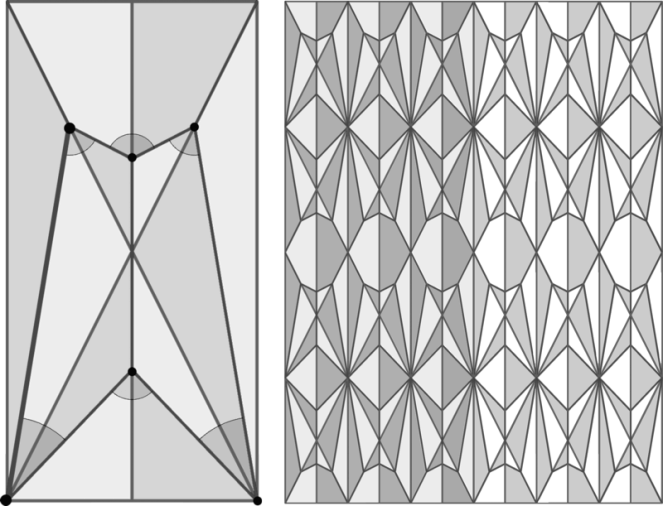
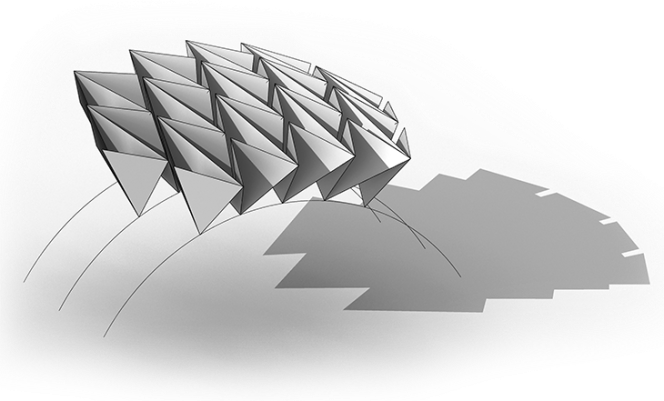
The movement is studied thanks to special algorithms compounded with Grasshopper, and using the physical simulator Kangaroo. The parametric code devised with the nodal system allows managing the mass of data, and then creating a series of geometric relations to be applied to each panel. This determines the single movement of the module, and then the variation of the overall shape.

Novedge: What is a recent project that you worked on?
Michele Calvano: The last project I have been working on is about the enhancement of cultural heritage through the dynamic digitization of a city's portions: an operation that I carried out in collaboration with Wissam Wahbeh and Pietro Cefaly. Modern techniques of integrated digital modeling are used to define interesting new research methodologies capable of putting together a multitude of information (documents, unrealized ideas, historical changes occurred over the years) as key instruments of knowledge of certain urban contexts. The research tells the story of an Italian city, Latina (capital of the province situated between Rome and Naples), whose urban structure is the result not only of entire sections or individual buildings, but also of political afterthoughts that have influenced its development.
These dynamic representations have brought to light that part of the city which was only designed, but never realized. In this way, knowledge of the urban structure was made available also to non-experts.
Latina is a young city that was founded in the 1920's. For this reason it was possible to find drawings of unrealized projects from which the creation of architectural models with Rhinoceros started. For the understanding of designed urban spaces, it was necessary contextualize them in “navigable” real-world environments. This was achieved through the photographic acquisition of interactive spherical panoramas from the gripping points (the place where panoramic photos were made) placed around the site in which to place virtually the reconstructed models.
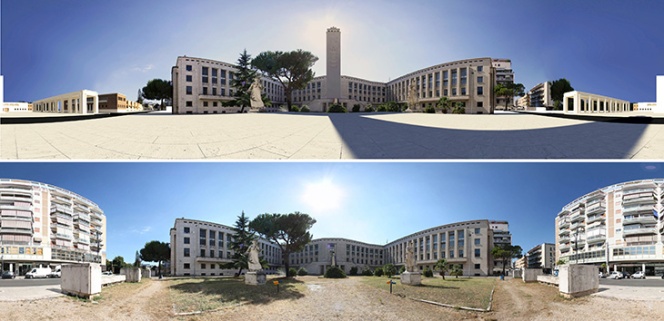
The idea is to relate the virtual model to the real urban space, within the spherical panoramas. These have several advantages: first of all, a quick and clear view of the city focusing on predefined points of view, in which the viewer can be positioned to observe the scene. The spherical panoramas have a field of view of 360 ° that allows us to perceive, together with the movement, the whole environment.
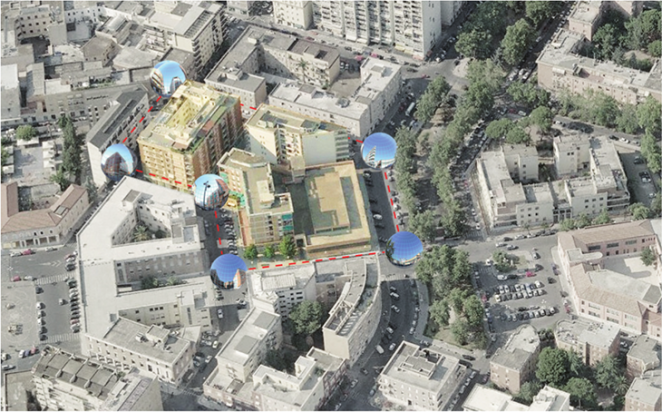
The same work has been done on the digital model of the reconstructed architecture, creating the rendering with cameras set in positions corresponding to the areas of real acquisition. In the end, a matching operation between the panoramic photographs and the panoramic rendering was done. This operation was performed on planar projections of photographs and panoramic renderings, inserting the digital architectures in the real space. The new spheres reassembled, linked to one another, offer a virtual tour (similar to Google Maps) able to illustrate, with dynamic images, places designed but never implemented.
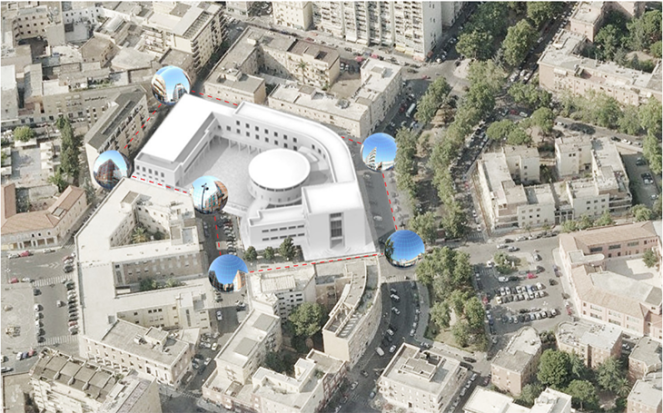
Novedge: What software do you use?
Michele Calvano: For the last ten years I have been madly in love with the Rhinoceros world, because of its flexibility. I am convinced that mathematical software can be divided into two categories: software useful in the concept phase, and software useful in the engineering phase. Rhino belongs to the first category, as it is capable of shaping concepts for architecture and design. Besides, it can be improved with suitable plug-ins that make it a great tool for solving specific problems. With the advent of Grasshopper a real revolution took place: the data becomes viewable geometry to be composed through algorithms that can be codified. I would not have been able to give an answer to the movement of origami if I had not approached it with a scripting system. Grasshopper makes accessible the language of the machine to the designer, by requiring the maximum simplification of transactions entered in the system. In addition, I think it is a valuable teaching tool, because it is a virtual laboratory in which one can work visually with the basic elements of computer graphics.

Novedge: What can artists learn from technologists and vice versa? Why is it important to explore the intersection of art and technology?
Michele Calvano: Considering architecture as a plastic visual art, one can answer this question by thinking about the evolution of the architect over time. This is possible through an analysis of how her formal language has changed, in some cases thanks to the increased familiarity with the new software and hardware technologies. New software has given confidence to the architects, who, with greater ease, deal with formal aspects, structural and functional at the same time, resulting in styles that flaunt technologisms. On the other hand, the understanding of meshes and NURBS representations managed by the new figure of computational designer has created a new organic explosion. Applications such as Grasshopper for Rhino and Dynamo for Revit and Vasari have opened the the world of programming to many architects, designers and artists by creating responsive systems which, urged by external inputs, give rise to moving figures in architecture, design and art.
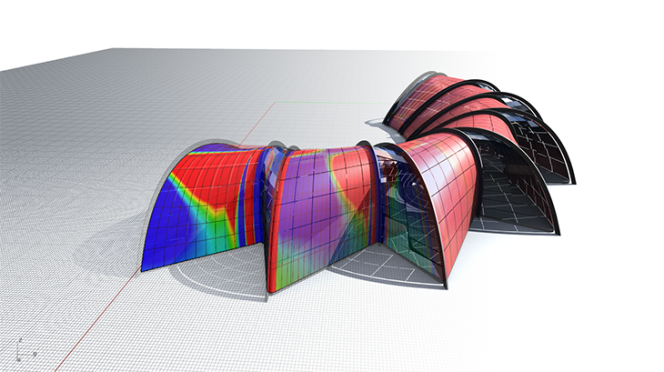
I believe the interrelation of art and technology is very important, in our fast-paced world which adds new layers of complexity every day. Technologies, now more and more accessible to the interested parties, become new tools for the understanding and use of complexity. To find complex solutions retaining human applications, it is necessary to intersect art and technology. This gives projects the chance to function and communicate.
Novedge: Who are some Italian architects that are relatively unknown abroad and whose work you'd like to see more widely recognized?
Michele Calvano: Despite having undertaken a research related to complex shapes, I find extremely interesting the work being done by DeliSabatini Architects. In their projects, I find the will to bypass the styles of our time by pursuing a language strongly tied to a continuity with that which is the architectural history of Italy, suddenly interrupted by the arrival of an international digital style. In their projects, whether realized or not, I read the need to mark the space through the clear design of maps and sections. Their own way to create complexity is achieved through clear multi-dimensional signs that dig in the cultural aspects of architecture.
Novedge: What's next for you?
Michele Calvano: My work, related to research in the representation of architectural and design models, aims to illustrate the latter in an interactive way within the digital space. The movement and the parameterization of models through compositional algorithms is the goal of the representations that we propose. The algorithms may be implicit, and then linked to a sequence of commands used for the resolution of the forms, or explicit through the use of nodal systems. This leads to reason about complex shapes with the aim to discretise them in order to represent them visually and physically. Through relief by means of laser-scanner or photogrammetry, the real space is discretised in a cloud of points, viewable through an algorithm capable of returning the mesh. The NURBS forms designed in order to create fascinating architectural skins need to be simplified, reduced to developable panels to make the created image achievable. Besides, the panels can move, creating responsive surfaces able to obey to the external inputs that inspire modification. The physical simulations on models may have a response only if the operation is carried out on properly tessellated shapes.
One of the topics of study of our group is the investigation of the relationship between real and digital, between micro and macro. We are putting this knowledge together to write a book in the future, in which the themes of digital representation recounted briefly in this interview will be treated in depth.
Michele's work is still mostly available in Italian, get in touch while he prepares the English version by visiting his blog and YouTube channel and by following him on Twitter.
Related articles
Also in NOVEDGE Blog
Subscribe
Sign up to get the latest on sales, new releases and more …





